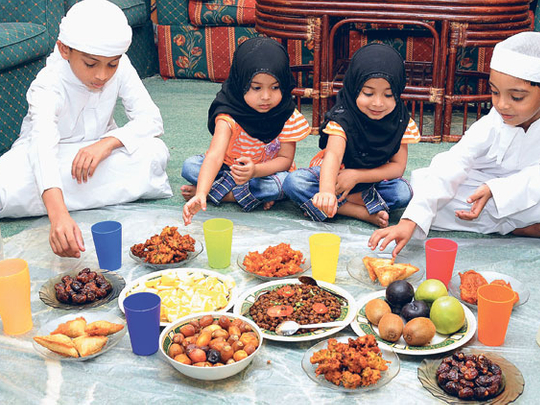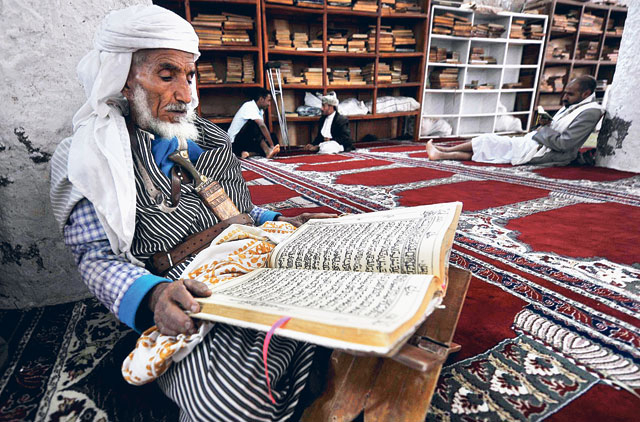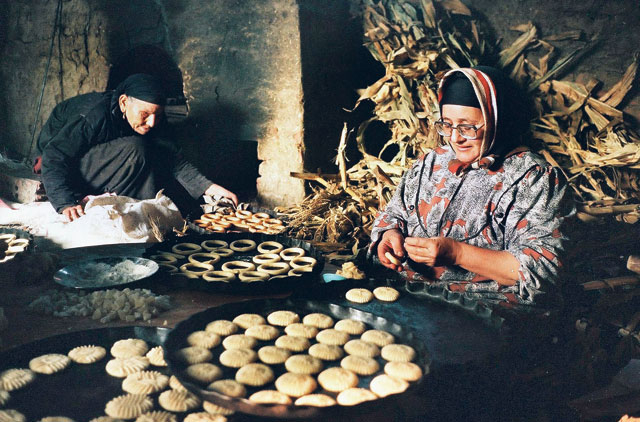
Islam, the fastest-growing religion in the world, has more than a billion followers across the globe and the number is steadily on the rise.
Today, there are Muslims living in almost every country, which can be attributed to trade routes, intermarriage, immigration and other factors. But while regional differences in food habits abound, the core traditions form an indivisible chain that binds the followers in their faith, especially during the holy month of Ramadan.
Regional interpretations
Intissar Al Fawwaz, a Jordanian who lived in Dubai till recently, echoed the importance of family. “It is a time for strengthening ties. As children, we were allowed to join in the rituals of the elders and learn to fast. By climbing the mosque a few steps at a time, we were able to graduate from a few hours to the whole day.
“My mother used to stock up for Ramadan with dry fruits and nuts. Cupboards were cleaned out and extra clothes were given to the poor. I remember waking up to the sound of musshirs beating their drums — it was a beautiful sound to wake up to. After iftar, every member of the family read a chapter of the Quran and then it was time for rejoicing.
“As for food, the iftar table is always a huge buffet. We would have diluted yoghurt, soup and juice. My favourite dish is the kataiefm — a pancake stuffed with walnuts, sugar and cinnamon, fried and dipped in honey syrup!”
Women sit with trays of sesame seeds, lentils, wheat and other grains and sort them by hand to ensure quality. These grains are taken to public ovens and left there under the watchful eye of a boy of the family.
Every Moroccan ends the fast with a soup called harira. This is a rich brown soup made of lentils, chickpeas, rice and meat stock. In traditional Rabati families, the soup includes pieces of meat. However, because Moroccans are of mixed origins, the soup can have a fesi taste (lighter, with more tomatoes) or a Marrakechi taste (heavier, with more vegetables).
Chebekkia is a cookie made from different kinds of grains and sweetened with honey, then sprinkled with sesame seeds. Most families drink milk sweetened with sugar or flavoured with apple, avocado and banana. Sfoof is a mixture of ground grains and sugar and tops the list of favourites. Hard-boiled eggs are also consumed, as they are rich in carbohydrates and protein. Cumin and salt are added to flavour the eggs.
Gharief and Moroccan crepes (the French influence) are sweetened breads and may not be traditional fare but are examples of how regional favourites find their way into the cuisine. Gharief can be prepared with oil, onions and spices or doused with honey and fried again. The crepes have a sour-dough taste and are eaten with cheese and jam.
Significance
Ramadan, which commemorates the revelation of the first verses of the Quran to the Prophet Mohammad (PBUH), is a month of fasting, piety and prayer.
After sohour before daybreak, Muslims fast during the day, and at maghreb, after the call to prayer, they join family and friends for iftar. In the UAE, this course of events has continued through the centuries, with people rushing home at sunset so that they can eat with their families.
After iftar, it is time for visiting the clan and friends and shopping, which figures largely on the agenda for the evening. The nights stretch till the late hours, as people do not go to bed until late.
Looking back
Mariam Behnam, a respected Emirati matriarch and author, reminiscences: “We had no radios — indeed, no electricity — and to wake up the neighbourhood, a man used to go around beating a drum. These town criers were called hil hilawi.
“It used to be an occasion when a child, usually at the age of 7, kept the fast for the first time. There were new clothes and gifts of money from the elders. I also remember shoorba, a rich soup cooked in huge pots by the manservants, while the maids prepared the other dishes, especially the sweets.
“For iftar, there was rosewater sherbet, lemons and araq bidamsek, another kind of sherbet. The beverages were put into narrow-necked jars and suspended into a well, to be drawn out just before iftar so that we could have it chilled. Now we have refrigerators and air-conditioners.”
Ending the fast
The people of Saudi Arabia, unlike the Egyptians, usually have only a small meal of dates and yoghurt, reserving the main meal for sohour. Dates are important to Muslims, as they are the prescribed food for ending the fast and have a special significance for Arabs in the Gulf.
Iraqis end their fast with lentil soup and qamar al deen, the apricot drink popular throughout the region. Then they tuck into kouba (baked rice dishes) and kunafa (a pastry confection).
Kuwaitis prefer agiina (a potato, meat and pepper dish), harissa (chicken with cinnamon) and machboos.
In Lebanon, as the Sun sets, Muslims rush home. Silence descends as they wait for the firing of a cannon to signal the end of the fast. Traditionally, the iftar meal begins with a glass of water and dates, fresh juice, lentil soup and fettoush (traditionally known as the poor man’s salad). The main meal is usually a meat stew.
During the evening visit to the family, it is customary to serve hadaf. Later, the city buzzes with activity with the sound of people on the streets, laughter and music.
Fawaneez, the coloured lamps so popular in Egypt, hang along the streets and khaimahs dot the landscape, with people watching chefs prepare Ramadan delicacies.
Popular dishes
“Harees, which is meat and wheat cooked together, is usually on the menu,” said Noor Al Deen Mustafa Abdul Latif, a prominent businessman, “but there are other dishes, such as machboos and fereed [naan soaked in salona, a kind of gravy]. The sweets are usually halwa, firni [a rice pudding] and umm ali [a rich milk pudding].”
His wife, Mona, a German-born practising Muslim, finds Ramadan peaceful and family-oriented. “This is one time that all families eat together, especially during sohour and iftar,” she said. Another Emirati added that she associates Ramadan with geresat (a fermented sweet dish) and legemat (fried sweet puffs).
Shisha, fanoos and khaimahs
In Egypt, two symbols — the shisha and the fanoos lamp — have become synonymous with Ramadan. Lit with electricity or candles, the fanoos lamp is a tradition dating back to the Fatimid times. The lamps are ubiquitous during Ramadan and are found in homes, shops, restaurants and even hanging along streets, which come alive with kids playing and singing traditional songs. Tents, called khaimahs, are put up and master pastry chefs, the fatari, demonstrate their skills at making traditional sweets. In the early hours of the morning, the musarati (town criers) walk through the neighbourhood, beating drums to awaken people for sohour.
In Egypt, special dishes are prepared for iftar: zahib, bondok, fosdok, looz and gooza (assorted nuts and raisins). Among the sweets are kunafa (shredded pastry with nuts and syrup), basbousah (a halwa with coconut), katayef (stuffed pancakes with honey syrup and nuts) and the drink qamar al deen, made from apricots. Besides, there is khaboos Ramadan, which is bread baked in a crescent shape. Every household has its own version of foul medams (fava beans), zabadi (yoghurt) and jars of torshi baladi (home-made pickles) for sohour.
Mohammad Ali Enaya, a teacher of Arabic, said: “We have a wonderful tradition of madfaa al iftar.” This is the firing of an old cannon to announce it is time to eat. As for beverages, the favourites are tamrhindi and arrq soss. Sweets include kunafa and qataif. An Iraqi man said of shisha: “These are smoked in tents during the all-night gatherings.”
Preserving tradition
In Yemen, Ramadan night celebrations are practices that go back about 1,400 years. While regional preferences vary, the religious significance remains the same. Ramadan nights in Sana’a are conducted in mosques or the homes of senior citizens. People sit in circles, chewing qat and discussing politics, culture and religion.
The daily activities during Ramadan evenings in Tarim, Hadramout province, usually start after prayers and continue until Al Taraweeh prayers. Around midnight, there is usually an interval, after which the discussion may continue till sohour.
In Zabid, the elders and religious scholars sit in a circle as the younger ones listen to recitation and interpretation. This happens every night, dealing with various sections of the Quran, from the first day of Ramadan. In Lahj province, apart from the religious readings, there are seminars, with intellectuals and authors talking about novels, and poetry readings.
A noted Yemeni lawyer and long-time resident of Dubai reminisced: “We had no TV or radio, so the spoken word was important. We sat in circles and listened to legends and religious stories. As I grew up in Aden, which had a strong Indian influence, apart from the usual shorba [rich meat soup], we used to eat samosas. However, my favourite sweet was bint al sabn, a bread confection soaked in honey. Another favourite was asidah, slow-cooked meat.”
The importance of family gatherings
“Family get-togethers become important,” said Fareed Lutfi, director of insurance services with Dubai Holdings. “All year round, the Lutfi clan meets for Saturday lunch at my mother’s house. During Ramadan we make it a point to include all the children and grandchildren, so the meal is on a Friday night. We are 11 brothers and sisters and our gatherings have almost 80 family members. Everyone looks forward to meeting at Nana’s house. Since our numbers have increased dramatically, many of us bring along a dish that is a speciality of the house.
“We feast on machboos [fish and rice, like a Spanish paella], biryani and maglooka [a Kuwaiti dish]. The dessert I enjoy is luqamat [a dumpling made with palm sugar or honey].”





